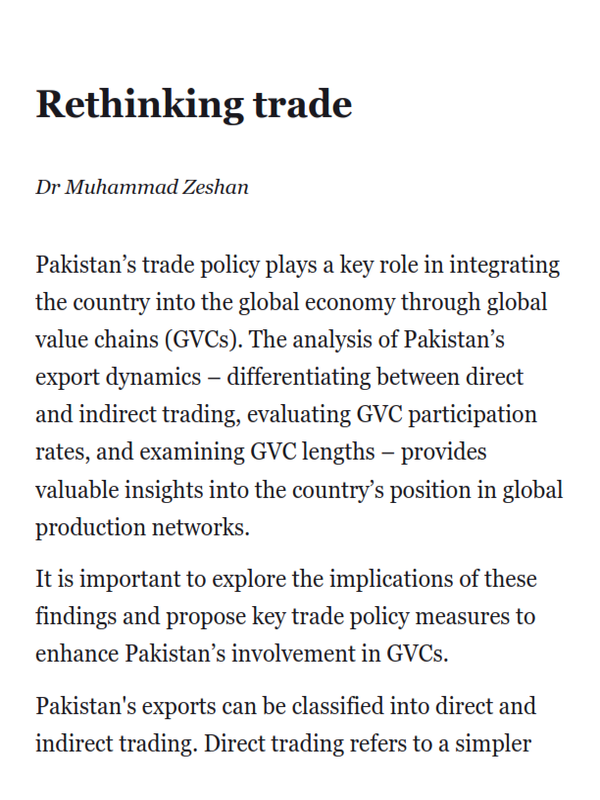Rethinking trade
Pakistan’s trade policy plays a key role in integrating the country into the global economy through global value chains (GVCs). The analysis of Pakistan’s export dynamics – differentiating between direct and indirect trading, evaluating GVC participation rates, and examining GVC lengths – provides valuable insights into the country’s position in global production networks.
It is important to explore the implications of these findings and propose key trade policy measures to enhance Pakistan’s involvement in GVCs.
Pakistan’s exports can be classified into direct and indirect trading. Direct trading refers to a simpler form of trade where solely Pakistan’s value-added is exported to and used by the importing country.
Direct trading exports accounted for $25.6 billion out of a total of $32.5 billion in gross exports in 2022. Indirect trading involves the incorporation of foreign value-added into the production process, exemplifying the cross-border production-sharing characteristic of GVCs. Pakistan’s indirect trading was around $6.9 billion in the same year.
By analyzing trade in terms of value-added, we can reveal hidden indirect trading connections not evident in traditional trade data. China serves as the initial destination for 15.8 per cent of Pakistan’s re-exported exports, while Bangladesh receive around 7.8 per cent of these exports. Additionally, China accounts for 17.4 per cent of the imported inputs used in Pakistan’s exports, followed by 12.8 per cent from the US. These findings highlight the significance of regional and global trading partners in Pakistan’s integration into GVCs.
GVC participation rates serve as a crucial measure of a country’s engagement in global production networks. Pakistan’s GVC participation rates have shown minimal growth over the past two decades, lagging behind other developing countries like Vietnam and Cambodia. To enhance these rates, the country needs to adopt targeted trade policies.
First, diversification of export sectors beyond textiles is essential to capture opportunities in emerging industries. This requires identifying sectors with growth potential and providing appropriate policy support to facilitate their development.
Second, improving the ease of doing business and creating an enabling environment for investment can attract foreign direct investment (FDI) and promote technological advancements. Investments in research and development, innovation, and skills development will enhance Pakistan’s competitiveness and enable it to participate in higher value-added segments of GVCs.
Third, fostering regional integration and connectivity is crucial. Pakistan should actively pursue regional trade agreements and initiatives, such as the South Asian Free Trade Area (SAFTA), to enhance trade flows within the region. This will facilitate greater cross-border investments, technology transfer, and knowledge-sharing, strengthening Pakistan’s position in regional and global value chains.
Pakistan primarily exports simple textile products and relies on foreign processing support to produce finished goods. To move up the value chain, it is imperative to strengthen domestic processing capabilities. Trade policies should focus on promoting domestic value addition and encouraging investments in advanced manufacturing technologies, research and development, and skills enhancement. This will enable Pakistan to undertake more stages of the production process domestically and increase the value-added components in its exports.
In the agriculture sector, where both domestic and foreign processing contribute to exports, trade policies should support the development of agro-industries and value chains. This involves improving infrastructure, facilitating access to finance, enhancing research and development in agricultural technologies, and promoting linkages between farmers and agro-processing industries. By doing so, Pakistan can enhance productivity, reduce post-harvest losses, and capture a greater share of value-added in agricultural exports.
Efficient trade facilitation measures and robust infrastructure are vital for integrating into GVCs. Trade policies should prioritize the simplification and harmonization of customs procedures, reducing trade costs, and facilitating cross-border trade. The implementation of single-window systems, automation of customs processes, and the establishment of trade information portals can expedite trade flows and enhance competitiveness.
Infrastructure development is equally important. Investments in transportation networks, logistics hubs and modernizing ports will improve connectivity, reduce transit times and lower logistics costs. Special economic zones and industrial parks should be established strategically, providing necessary infrastructure, utilities, and incentives to attract investment and promote manufacturing activities linked to GVCs.
To effectively participate in GVCs, Pakistan must invest in skills development and human capital. Trade policies should emphasize education and vocational training programmes aligned with industry needs. By equipping the workforce with relevant skills, Pakistan can meet the demands of higher value-added production processes, attract quality jobs, and improve labour productivity. Collaboration between the government, private sector, and educational institutions is crucial to bridge the skills gap and foster a capable workforce for GVC-related industries.
Pakistan’s trade policy can reshape its involvement in GVCs and global production networks. By leveraging the insights gained from analyzing direct and indirect trading, evaluating GVC participation rates, and understanding GVC lengths, Pakistan can devise targeted policies to enhance its integration into GVCs.
To maximize its potential, Pakistan should focus on diversifying export sectors, strengthening domestic processing capabilities, fostering regional integration, facilitating trade, investing in infrastructure, and promoting skills development.
By implementing these measures, Pakistan can harness the opportunities offered by GVCs, attract investments, upgrade its industries, and achieve sustained and inclusive economic growth.
The writer is a research fellow at the Pakistan Institute of Development Economics (PIDE).




